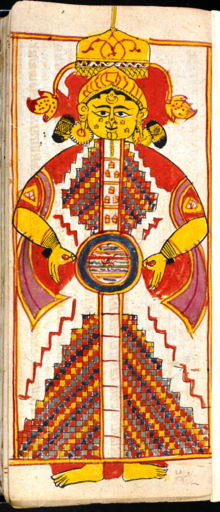Trailokya

Trailokya (Sanskrit: त्रैलोक्य; Kannada: ತ್ರೈಲೋಕ್ಯ; Pali: tiloka, Tibetan: khams gsum; Chinese: 三界; Vietnamese: Tam Giới) literally means "three worlds".[1][2][3] It can also refer to "three spheres,"[3] "three planes of existence,"[4] and "three realms".[4]
Conceptions of three worlds (tri-loka) appear in Hinduism and Jainism, as well as early Buddhist texts.


Hindu cosmology
| Part of a series on |
| Hinduism |
|---|
 |
|
Main article: Hindu cosmology |
The concept of three worlds has a number of different interpretations in Hindu cosmology.
- Traditionally, the three worlds refer to either the earth (Bhuloka), heaven (Svarga), and hell (Naraka),[5] or the earth (Bhuloka), heaven (Svarga), and the netherworld (Patala)[6]
- The Brahmanda Purana conceives them to be Bhūta (past), Bhavya (future), and Bhavat (present)[7]
- In Vaishnavism, the three worlds are often described to be bhūr, bhuvaḥ, and svaḥ (the gross region, the subtle region, and the celestial region)[8]
- In the Nilanamatapurana, Vamana covers his second step on the three worlds of Maharloka, Janaloka, and Tapoloka, all of which are regarded to be a part of the seven heavens[9]
Buddhist cosmology
|
Main article: Buddhist cosmology |
In Buddhism, the three worlds refer to the following destinations for karmic rebirth:
- Kāmaloka the world of desire, typified by base desires, populated by hell beings, preta (hungry ghosts), animals, humans and lower demi-gods.
- Rūpaloka is the world of form, predominantly free of baser desires, populated by dhyāna-dwelling gods, possible rebirth destination for those well practiced in dhyāna.
- Arūpaloka is the world of formlessness, a noncorporeal realm populated with four heavens, possible rebirth destination for practitioners of the four formlessness stages.[3]
Together, they make up all of existence.
Jain cosmology
The early Jain contemplated the nature of the earth and universe and developed a detailed hypothesis on the various aspects of astronomy and cosmology. According to the Jain texts, the universe is divided into 3 parts:[10][11][12][13]
Text is available under the CC BY-SA 4.0 license; additional terms may apply.
Images, videos and audio are available under their respective licenses.

